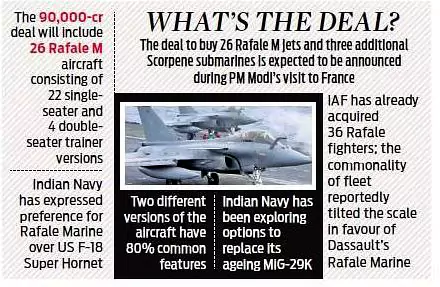Context: India has initiated the formal process to acquire 26 Rafale Marine (M) fighter jets and associated equipment from France.


| Feature | Rafale M | Rafale |
| Airframe |
|
|
| Wing |
|
|
| Tailhook |
|
|
| Radar |
|
|
| Weapons |
|
|
| Mission |
|
|
|
|
|
|
|
|
|
|
| Category | DPP 2016 | DAP 2020 |
| Buy (India -IIDM) |
|
|
| Buy (India) |
|
|
| Buy and Make (India) |
|
|
| Buy (Global – Manufacturer in India) |
|
|
| Buy (Global) |
|
|
| Must Read | |
| NCERT Notes For UPSC | UPSC Daily Current Affairs |
| UPSC Blogs | UPSC Daily Editorials |
| Daily Current Affairs Quiz | Daily Main Answer Writing |
| UPSC Mains Previous Year Papers | UPSC Test Series 2024 |
Yes, The Rafale Marine version has features like Strengthened carrier landings, Foldable wings, Maritime-optimised, Wider range of weapons, including anti-ship missiles and improved Carrier operations
The acceptance of necessity to acquisition proposals is granted by the Defence Acquisition Council after which the Defence Ministry initiates the procurement process.
The Defence minister is the chairman of DAC. Its members include the Chief of Defence Staff (CDS) and chiefs of the Army, Navy, and Air Force.
The Defence Acquisition Procedure (DAP) 2020 has been established in 2020 as a potential catalyst for the Atmanirbhar Bharat Abhiyaan, in the sector of defence manufacturing.

<div class="new-fform">
</div>